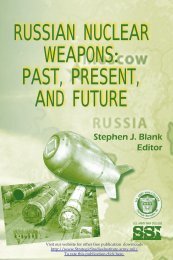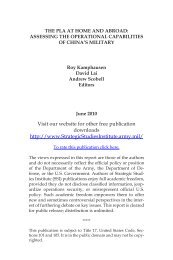The United States and China in Power Transition - Strategic Studies ...
The United States and China in Power Transition - Strategic Studies ...
The United States and China in Power Transition - Strategic Studies ...
Create successful ePaper yourself
Turn your PDF publications into a flip-book with our unique Google optimized e-Paper software.
Ch<strong>in</strong>ese critiques of the harmonious world construct. He rightly<br />
po<strong>in</strong>ts out that this harmonious world construct is not a “theory”<br />
as many other Ch<strong>in</strong>ese analysts have claimed; it is a questionable<br />
design for world peace; it is at best a Ch<strong>in</strong>ese government<br />
policy call. See Xu Shaom<strong>in</strong> (许少民), “和谐世界:口号还是战略?”<br />
(“Harmonious World Construct: A Policy Call or a Strategy?”) 中<br />
国选举与治理网, available from www.ch<strong>in</strong>aelections.org.<br />
35. <strong>The</strong> Five Pr<strong>in</strong>ciples of Peaceful Co-Existence are: 1) mutual<br />
respect for sovereignty <strong>and</strong> territorial <strong>in</strong>tegrity; 2) mutual<br />
non-aggression; 3) non<strong>in</strong>terference <strong>in</strong> each other’s <strong>in</strong>ternal affairs;<br />
4) equality <strong>and</strong> mutual benefit; <strong>and</strong> 5) peaceful co-existence. Ch<strong>in</strong>ese<br />
Premier Zhou Enlai first specified the five pr<strong>in</strong>ciples <strong>in</strong> their<br />
entirety <strong>in</strong> a meet<strong>in</strong>g with the visit<strong>in</strong>g Indian government delegation<br />
<strong>in</strong> Beij<strong>in</strong>g on December 31, 1953. By the way, the Indians also<br />
claim ownership of these five pr<strong>in</strong>ciples.<br />
36. Hu J<strong>in</strong>tao, “Build Towards a Harmonious World of Last<strong>in</strong>g<br />
Peace <strong>and</strong> Common Prosperity,” Speech at the UN Summit,<br />
New York, September 15, 2005, available from www.ch<strong>in</strong>a-un.<br />
org/eng/zt/shnh60/t212915.htm. Two years later, at the CCP’s 17th<br />
Party Convention, Hu provided a further elaboration of this construct.<br />
See Hu J<strong>in</strong>tao, “Report to the 17th CCP Party Convention,<br />
Section XI,” October 25, 2007.<br />
37. See Chen Xiangyang (陈向阳), “有效应对西方 ‘话语霸权’<br />
挑战” (“Effectively Challenge the West’s ‘Speech Hegemonism’”),<br />
瞭望新闻周刊 (Outlook Weekly), March 29, 2010. Jiang Yong (江涌),<br />
“中国要说话, 世界在倾听” (“<strong>Ch<strong>in</strong>a</strong> Has Th<strong>in</strong>gs to Say, the World<br />
Is Listen<strong>in</strong>g”), 决策探索 (Decision <strong>Studies</strong>), March 2010.<br />
38.Yang Jiemian (杨洁勉), “和谐世界理念与中国国际战略发<br />
展” (“Idea of ‘Harmonious World’ <strong>in</strong> <strong>Ch<strong>in</strong>a</strong>’s International <strong>Strategic</strong><br />
Development”), 国际问题研究 (International <strong>Studies</strong>), No. 5,<br />
2009; Li Dan (李丹), “和谐社会与和谐世界: 中国内外治理的新构<br />
想” (“Harmonious Society <strong>and</strong> Harmonious World: <strong>Ch<strong>in</strong>a</strong>’s New<br />
Construct for Internal <strong>and</strong> External Order”), 长沙理工大学学报 (<br />
社会科学版) (Journal of Changsha University of Science & Technology<br />
[Social Science]), Vol. 23, No. 2, January 2008; Cheng Yunchuan (<br />
程云川), “推动建设和谐世界论的当代价值” (“<strong>The</strong> Contemporary<br />
Value of Advocat<strong>in</strong>g the Harmonious World Construct”), 福建论<br />
坛 (Fujian Forum), No. 2, 2010; Ban Xiup<strong>in</strong>g (班秀萍), “‘共产党宣<br />
209

















